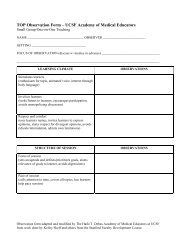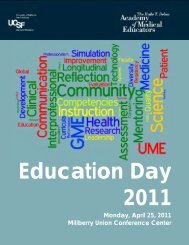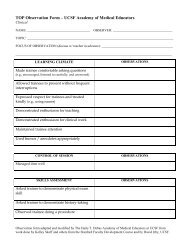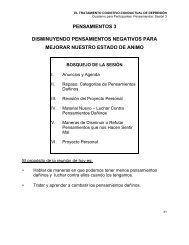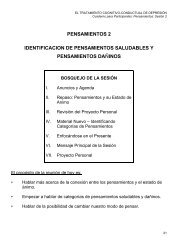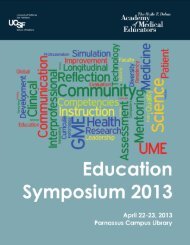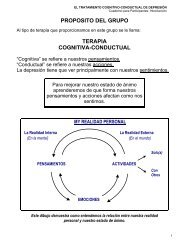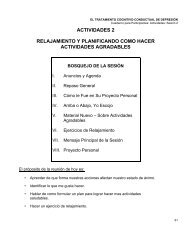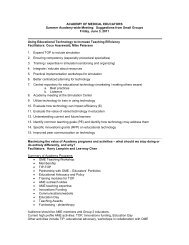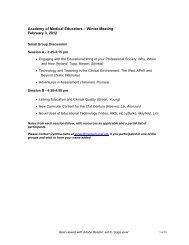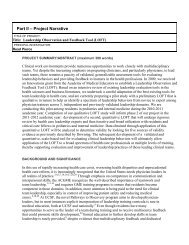Preparing for an ACGME Site Visit Workshop PPT Slides
Preparing for an ACGME Site Visit Workshop PPT Slides
Preparing for an ACGME Site Visit Workshop PPT Slides
Create successful ePaper yourself
Turn your PDF publications into a flip-book with our unique Google optimized e-Paper software.
<strong>ACGME</strong> <strong>Site</strong> <strong>Visit</strong>s<br />
Sus<strong>an</strong> B. Promes, MD<br />
Acting DIO, Office of GME<br />
Professor & Program Director<br />
Department of Emergency Medicine
Agenda<br />
• Intro <strong>an</strong>d Overview<br />
• Guide to Navigating the Accreditation<br />
Websites <strong>an</strong>d Systems<br />
• <strong>Preparing</strong> the PIF<br />
Break<br />
• <strong>Preparing</strong> <strong>for</strong> the Big Day<br />
• RRC Perspective
Know your Program<br />
Requirements
<strong>ACGME</strong> Competencies<br />
(Outcomes Project)<br />
• Patient Care<br />
• Medical Knowledge<br />
• Interpersonal Communication Skills<br />
• Professionalism<br />
• System Based Practice<br />
• Practice Based Learning <strong>an</strong>d Improvement
The Review Process<br />
• Peer Review by RRC member using the<br />
following in<strong>for</strong>mation to determine compli<strong>an</strong>ce<br />
with the program requirements:<br />
Program<br />
In<strong>for</strong>mation<br />
Form (PIF)<br />
<strong>Site</strong> <strong>Visit</strong><br />
Report<br />
Resident<br />
Survey<br />
Faculty<br />
Survey<br />
Procedure -<br />
Case Logs<br />
Board Pass<br />
Rates<br />
2013 - New<br />
Accreditation<br />
System<br />
• Peer Reviewers present assessment of the<br />
program to the entire RRC<br />
• RRC determines degree of compli<strong>an</strong>ce <strong>an</strong>d<br />
assigns accreditation status along with review<br />
cycle r<strong>an</strong>ge of 1-5 years
<strong>Site</strong> <strong>Visit</strong>or Interviews<br />
• Questions to verify <strong>an</strong>d clarify how your<br />
program addresses the requirements<br />
– Program Director <strong>an</strong>d Coordinator<br />
– Chair<br />
–DIO<br />
– Faculty<br />
– Residents<br />
Be prepared with supporting documentation
New Schedule <strong>for</strong> <strong>Site</strong> <strong>Visit</strong>ors<br />
• SV solicits list of program’s strengths <strong>an</strong>d<br />
opportunities <strong>for</strong> improvement<br />
– Brief meeting with PD <strong>an</strong>d coordinator<br />
– Interviews Residents<br />
– Interviews Faculty<br />
– Meets with PD <strong>an</strong>d coordinator<br />
– Preliminary feedback to the PD on findings
New Methodology <strong>for</strong> <strong>Site</strong> Reviews<br />
Shift to program operations <strong>an</strong>d implementation<br />
•Review of Citations<br />
•Issues identified by residents<br />
•Resident (<strong>an</strong>d faculty) survey data<br />
•Duty Hours<br />
Focus on ongoing ch<strong>an</strong>ges, improvements
Alertness M<strong>an</strong>agement<br />
Fatigue Mitigation<br />
• Educate all residents<br />
<strong>an</strong>d faculty<br />
• Adopt processes to<br />
m<strong>an</strong>age possible<br />
negative effects of<br />
fatigue on patient care<br />
<strong>an</strong>d learning<br />
– Naps, back up<br />
schedules
Tr<strong>an</strong>sitions in Care<br />
• Documented process<br />
in place <strong>for</strong> assuring<br />
effective h<strong>an</strong>d-offs<br />
• Ensure competency<br />
– Education<br />
– Assessment<br />
• Consider<br />
– Short lectures, chart<br />
review, peer teaching<br />
<strong>an</strong>d evaluation
Red Flags<br />
• Poor preparation <strong>for</strong> accreditation process<br />
• Program leadership ch<strong>an</strong>ges<br />
• Faculty (qualifications, number, hours<br />
dedicated to the program, turnover)<br />
• Didactic program<br />
• Evaluation program<br />
• Support (fin<strong>an</strong>cial <strong>an</strong>d support staff)
Red Flags<br />
• Scholarly work<br />
• Appropriate volume <strong>an</strong>d variety of patients<br />
• Procedural experience<br />
• Issues with recruitment <strong>an</strong>d retention<br />
• PIFm<strong>an</strong>ship (Program Director<br />
Responsibilities)<br />
• Faculty or residents not available <strong>for</strong><br />
meeting with SV
New Accreditation Process<br />
• 7 specialties:<br />
– Internal Medicine<br />
– Pediatrics<br />
– Radiology<br />
– Emergency Medicine<br />
– Urology<br />
– Orthopedics<br />
– Neurosurgery
Milestones<br />
• Benchmarks of skills<br />
<strong>an</strong>d knowledge that<br />
residents must<br />
achieve in certain<br />
stages in their<br />
residency<br />
• Document steadily<br />
increasing mastery of<br />
6 core competencies
New Institutional<br />
Accreditation Process<br />
(CLER)<br />
• Periodic visits every 18 months<br />
– Short notice of visits<br />
– Senior leadership of sponsoring institution<br />
<strong>an</strong>d the primary clinical site will be expected<br />
to participate<br />
• Initial visits will begin in final quarter of<br />
2012
Heather A. Nichols<br />
Accreditation M<strong>an</strong>ager<br />
Office of Graduate Medical Education<br />
Mystery Solved!<br />
Your Guide to Finding <strong>an</strong>d<br />
Navigating Key<br />
Accreditation Websites <strong>an</strong>d<br />
Systems
Overview<br />
• <strong>ACGME</strong> Website<br />
• <strong>ACGME</strong> Accreditation Data System (ADS)<br />
• <strong>ACGME</strong> e-Communication<br />
• UCSF GME Accreditation Database (Sales<strong>for</strong>ce)<br />
• UCSF GME website
<strong>ACGME</strong> Website: Key Pages<br />
• Residency Review Committee (RRC) homepage<br />
– Program requirements<br />
– PIF<br />
– FAQs<br />
– RRC meeting dates <strong>an</strong>d newsletters<br />
• <strong>Site</strong> <strong>Visit</strong> & Field Staff Tab<br />
– FAQs<br />
– <strong>Site</strong> visit checklist<br />
– Field staff bios<br />
• New pages to keep <strong>an</strong> eye on<br />
– The Next Accreditation System<br />
– Approved St<strong>an</strong>dards (2011 program requirements)
<strong>ACGME</strong> Accreditation Data System<br />
(ADS)<br />
• Login required (issued by <strong>ACGME</strong>)<br />
• Key site visit documents/processes:<br />
– PIF<br />
– Faculty CVs<br />
– Resident/Fellow/Faculty Survey<br />
– RRC notification letters<br />
– Participating sites<br />
– Trainees<br />
• Misc.<br />
– Ch<strong>an</strong>ge in resident complement request<br />
– Annual Program Update<br />
– Case logs
<strong>ACGME</strong> e-Communication<br />
• Sent by <strong>ACGME</strong> to PDs <strong>an</strong>d PCs listed in ADS
UCSF GME Accreditation Database<br />
(Sales<strong>for</strong>ce)<br />
• Login required (issued by Office of GME)<br />
• “Libraries” Tab<br />
– Your programs key accreditation documents<br />
(policies, goals <strong>an</strong>d objectives, <strong>an</strong>nual program<br />
director survey, internal review reports, etc.)<br />
– ALL previously completed UCSF GME PIFs<br />
• “Reports” Tab: GME Accreditation folder<br />
– <strong>Site</strong> <strong>Visit</strong>or Summary report
Key <strong>ACGME</strong> Webpages<br />
• RRC Homepage<br />
http://www.acgme.org/acWebsite/navPages/nav_comRRC.<br />
asp<br />
• Program Directors & Coordinators<br />
http://www.acgme.org/acWebsite/navPages/nav_PDcoord.<br />
asp<br />
• Field Staff FAQs<br />
http://www.acgme.org/acWebsite/fieldStaff/fs_faq.asp<br />
• Field Staff Bios<br />
http://www.acgme.org/acWebsite/fieldStaff/fs_faq.asp<br />
• Next Accreditation System<br />
http://www.acgme-nas.org/<br />
• Approved St<strong>an</strong>dards (2011 program requirements)<br />
http://www.acgme-2010st<strong>an</strong>dards.org/
Misc. Key Websites<br />
• ADS<br />
– https://www.acgme.org/ads/default.asp<br />
– Login: Assigned by <strong>ACGME</strong><br />
• UCSF GME Accreditation Database<br />
– https://login.sales<strong>for</strong>ce.com/<br />
– Login: One per program, assigned to program<br />
coordinator to share with program director<br />
• UCSF GME Website: Program Letter of<br />
Agreement Template<br />
– http://medschool.ucsf.edu/gme/Prog_Resources/taa.<br />
html
Questions?<br />
Contact Heather Nichols, Accreditation M<strong>an</strong>ager<br />
nicholsha@medsch.ucsf.edu
<strong>Preparing</strong> the<br />
<strong>ACGME</strong> Program<br />
In<strong>for</strong>mation Form (PIF)<br />
Claire Brett, MD: Vice Chair, GMEC
Do <strong>an</strong>d Don’t: PREPARING THE PIF<br />
PROGRAM<br />
DIRECTOR<br />
PROGRAM<br />
COORDINATOR<br />
PIF<br />
DIO<br />
GME:<br />
Brett<br />
Nichols<br />
Others
PIF: Sections<br />
• Common: electronic<br />
• Subspecialty: electronic vs “word”<br />
• Specialty: electronic vs “word”
Common Electronic PIF<br />
• Accreditation In<strong>for</strong>mation<br />
• Citation In<strong>for</strong>mation<br />
response to previous citations<br />
major ch<strong>an</strong>ges<br />
• Participating <strong>Site</strong>s<br />
Sponsoring institution<br />
Primary <strong>Site</strong> (<strong>Site</strong> #1)<br />
Participating <strong>Site</strong> (<strong>Site</strong> #2, 3)<br />
brief educational rational<br />
PLA<br />
Integrated<br />
• Faculty/Teaching Staff<br />
Program Director in<strong>for</strong>mation<br />
• Physici<strong>an</strong> Faculty Roster<br />
• Non-Physici<strong>an</strong> Faculty Roster<br />
• Physici<strong>an</strong> CV’s<br />
• Resident appointments<br />
• Evaluation<br />
Methods of evaluation: Competencies<br />
• Evaluators: educated on assessments<br />
Residents: in<strong>for</strong>med of methods<br />
Ensuring that faculty complete evaluations<br />
Process to complete/document semi<strong>an</strong>nual evaluations<br />
Annual confidential evaluations of faculty<br />
Feedback to faculty<br />
Program evaluation<br />
• Program improvement: program evaluation/<strong>ACGME</strong> Survey
Common Electronic PIF<br />
• Duty Hours<br />
• Back up system: clinical care needs exceed the residents' ability<br />
• Describe how clinical assignments are designed to minimize the<br />
number of tr<strong>an</strong>sitions in patient care<br />
• The program & the sponsoring institution: ensure that h<strong>an</strong>d-over<br />
processes facilitate both continuity of care & patient safety<br />
• Indicate how your program educates residents to recognize the<br />
signs of fatigue & sleep deprivation<br />
• Facilities & amenities available to residents on-call<br />
• Tr<strong>an</strong>sportation options the program or institution offer residents<br />
who may be too fatigued to safely return home<br />
• Describe how the program director & faculty evaluate the<br />
resident's abilities to determine progressive authority &<br />
responsibility, conditional independence & a supervisory role<br />
• Moonlighting<br />
• Describe ambulatory <strong>an</strong>d non-hospital settings other th<strong>an</strong> the<br />
inpatient experience<br />
• Describe residents' use of electronic medical records & how this<br />
contributes to their education
Specialty PIF<br />
• Pediatric subspecialty PIF<br />
Faculty research<br />
Research resources<br />
Program curriculum<br />
Block diagram<br />
Goals <strong>an</strong>d objectives<br />
Conferences<br />
Fellow research activities<br />
• Specialty specific PIF<br />
Facilities <strong>an</strong>d services<br />
Patient care<br />
Medical knowledge<br />
PBL <strong>an</strong>d improvement<br />
Professionalism<br />
System based practice
PREPARING THE PIF<br />
Timeline: early; monitor; revise<br />
• GME<br />
• Program<br />
• Update ADS<br />
Assignments<br />
• CV’s<br />
• Logs<br />
• Data <strong>for</strong> each site<br />
Program Requirements are the guide<br />
PD writes the PIF: one voice<br />
Resources<br />
• <strong>ACGME</strong>/weekly e-Communications<br />
• Other PD: internal <strong>an</strong>d program<br />
• Other Coordinators<br />
• PIF library: electronic via OGME<br />
• RRC/site visitor
PREPARING THE PIF<br />
Timeline:<br />
<strong>Site</strong> <strong>Visit</strong> July 1<br />
• Notification from RRC: 110-120 days March 1<br />
• <strong>Site</strong> visitor sends instructions March 8<br />
• <strong>Site</strong> visitor: 2 weeks be<strong>for</strong>e site visit June 15<br />
• DIO: 3 weeks be<strong>for</strong>e site visit June 8<br />
• Final PIF: 4-6 weeks be<strong>for</strong>e site visit June 1<br />
• First draft: 2-3 months be<strong>for</strong>e site visit April 1
PREPARING THE PIF<br />
Style<br />
• Avoid abbreviations<br />
• Never refer the reviewer to <strong>an</strong>other<br />
section of the PIF; every <strong>an</strong>swer<br />
st<strong>an</strong>ds alone, even if repetitive.<br />
• Bullets rather th<strong>an</strong> paragraphs<br />
• Answer THE QUESTION; avoid<br />
extr<strong>an</strong>eous/irrelev<strong>an</strong>t in<strong>for</strong>mation<br />
• Final PIF: no ch<strong>an</strong>ges <strong>for</strong> site visit<br />
No materials after the site visit
PREPARING THE PIF<br />
Avoid Abbreviations<br />
NP fellows are admitted into the<br />
program from one of two routes:<br />
1) through combined AP/NP residency<br />
or<br />
2) as <strong>an</strong> NP fellow after completion of<br />
Americ<strong>an</strong> Board of Pathology<br />
requirements in AP/CP or AP only<br />
residency.
PREPARING THE PIF<br />
Answer the Question<br />
“Describe your educational program”<br />
≠<br />
Goals <strong>an</strong>d Objectives
PREPARING THE PIF<br />
Answer the Question<br />
Faculty Roster<br />
“List alphabetically <strong>an</strong>d by site all physici<strong>an</strong> faculty who<br />
devote at least 10 hours a week to resident education”
PREPARING THE PIF:<br />
Content<br />
• Identify a team of readers to review<br />
• Check consistency among<br />
data/narrative/tables
PREPARING THE PIF:<br />
Content<br />
• Complete: response clear to <strong>an</strong>y reader<br />
• Compli<strong>an</strong>t: program<br />
requirements/provide evidence <strong>for</strong><br />
response<br />
• Correct: accurate data? Consistent<br />
among sections/tables
PREPARING THE PIF:<br />
Content
PREPARING THE PIF<br />
Answer the Question<br />
Describe how fellows:<br />
a) Develop teaching skills necessary to educate patients,<br />
families, students, <strong>an</strong>d other residents;<br />
b)Teach patients, families, <strong>an</strong>d others; <strong>an</strong>d<br />
c)Receive <strong>an</strong>d incorporate <strong>for</strong>mative evaluation feedback into daily<br />
practice. (If a specific tool is used to evaluate these skills have it<br />
available <strong>for</strong> review by the site visitor.)<br />
a) Fellows develop teaching skills:<br />
b) Fellows teach patients, families, <strong>an</strong>d others:<br />
c) Fellows receive <strong>an</strong>d incorporate <strong>for</strong>mative evaluation:
PREPARING THE PIF<br />
Answer the Question<br />
“Discuss the org<strong>an</strong>ization <strong>an</strong>d assignment of A&I resident outpatient activities,<br />
type of clinical practice, e.g., hospital, clinic, private practice, <strong>an</strong>d whether A&I<br />
residents have other responsibilities during outpatient assignments.”<br />
The pediatric immunology practice at UCSF beg<strong>an</strong> in 1979 under the direction of<br />
Dr. AAA. In 1984, Dr . BBB, already a leader in pediatric immunology <strong>an</strong>d<br />
HIV/AIDS in children, became the Director of Pediatric<br />
Immunology/Rheumatology as well <strong>an</strong>d retained the primary responsibility <strong>for</strong><br />
supervising the inpatient <strong>an</strong>d outpatient clinical program <strong>for</strong> the diagnosis <strong>an</strong>d<br />
treatment of children with primary immunodeficiency disorders until 2010. Going<br />
<strong>for</strong>ward, Dr. BBB will continue to direct the HIV/AIDS program <strong>an</strong>d will<br />
participate in the primary immunodeficiency program, the latter now Directed by<br />
Dr. CCC. The Immunology Clinic directed by Dr. CCC will be the site of initial<br />
evaluation of inf<strong>an</strong>ts born in Northern Cali<strong>for</strong>nia who are identified through<br />
universal newborn screening to have low T cell receptor excision circles, or<br />
TRECs, <strong>an</strong>d low or absent T lymphocytes. These inf<strong>an</strong>ts, seen between 4 <strong>an</strong>d 6<br />
weeks of age, may have SCID or other known or as yet unrecognized conditions<br />
associated with primary or secondary T lymphocytopenia….
PREPARING THE PIF<br />
Answer the Question<br />
“Discuss the org<strong>an</strong>ization <strong>an</strong>d assignment of A&I resident<br />
outpatient activities, type of clinical practice, e.g., hospital,<br />
clinic, private practice, <strong>an</strong>d whether A&I residents have<br />
other responsibilities during outpatient assignments.”<br />
The outpatient activities of the Allergy & Immunology<br />
resident:<br />
• Org<strong>an</strong>ization/type of clinical practice<br />
• Assignment<br />
• Other responsibilities
PREPARING THE PIF<br />
Answer the Question<br />
Faculty CV’s<br />
• Academic Appointments - List the past ten years,<br />
beginning with your current position.<br />
• Concise Summary of Role in Program<br />
• Current Professional Activities / Committees (limit of 10)<br />
• Selected Bibliography - Most representative Peer<br />
Reviewed Publications / Journal Articles from the last 5 years<br />
(limit of 10):<br />
• Selected Review Articles, Chapters <strong>an</strong>d / or Textbooks<br />
from the last 5 years (limit of 10)<br />
• Participation in Local, Regional, <strong>an</strong>d National Activities /<br />
Presentations / Abstracts / Gr<strong>an</strong>ts from the last 5 years<br />
(limit of 10)
PREPARING THE PIF<br />
Answer the Question<br />
Faculty CV’s<br />
Current Professional Activities / Committees (limit of 10):<br />
[2007 - 2008] Chair, Cali<strong>for</strong>nia Society of Anesthesiologists,<br />
Resident Research Competition
PREPARING THE PIF<br />
Answer the Question<br />
Faculty CV’s
PREPARING THE PIF<br />
Answer the Question<br />
Faculty CV’s
PIF<br />
Describe one learning<br />
activity in which residents<br />
engage to identify strengths,<br />
deficiencies, <strong>an</strong>d limits in<br />
their knowledge <strong>an</strong>d<br />
expertise (self-reflection <strong>an</strong>d<br />
self-assessment); set<br />
learning <strong>an</strong>d improvement<br />
goals; identify <strong>an</strong>d per<strong>for</strong>m<br />
appropriate learning activities<br />
to achieve self-identified<br />
goals (life-long learning).<br />
PROGRAM REQUIREMENTS<br />
Residents must demonstrate the ability<br />
to investigate & evaluate their care of<br />
patients, to appraise & assimilate<br />
scientific evidence, & to continuously<br />
improve patient care based on const<strong>an</strong>t<br />
self-evaluation & life-long learning.<br />
Residents are expected to develop skills<br />
<strong>an</strong>d habits to be able<br />
• identify strengths,<br />
deficiencies, & limits in one’s knowledge<br />
& expertise<br />
• set learning <strong>an</strong>d<br />
improvement goals<br />
• identify & per<strong>for</strong>m<br />
appropriate learning activities<br />
• systematically <strong>an</strong>alyze<br />
practice using quality improvement<br />
methods, & implement ch<strong>an</strong>ges with the<br />
goal of practice improvement<br />
• incorporate <strong>for</strong>mative<br />
evaluation feedback into daily practice<br />
• locate appraise <strong>an</strong>d
PIF<br />
Describe one learning<br />
activity in which residents<br />
develop competence in<br />
communicating effectively<br />
with patients <strong>an</strong>d families<br />
across a broad r<strong>an</strong>ge of<br />
socioeconomic <strong>an</strong>d cultural<br />
backgrounds, <strong>an</strong>d with<br />
physici<strong>an</strong>s, other health<br />
professionals, <strong>an</strong>d health<br />
related agencies.<br />
PROGRAM REQUIREMENTS<br />
Residents must demonstrate<br />
interpersonal & communication skills<br />
that result in the effective exch<strong>an</strong>ge of<br />
in<strong>for</strong>mation & collaboration with patients,<br />
their families, & health professionals<br />
• communicate effectively with<br />
patients, families, & the public, across a<br />
broad r<strong>an</strong>ge of socioeconomic & cultural<br />
backgrounds<br />
• communicate effectively with<br />
physici<strong>an</strong>s, other health professionals,<br />
related agencies<br />
• work effectively as a<br />
member or leader of a health care team<br />
or other professional group<br />
• act in a consultative role to<br />
other physici<strong>an</strong>s <strong>an</strong>d health<br />
professionals<br />
• maintain comprehensive,<br />
timely, & legible medical records
PREPARING THE PIF<br />
• Describe one learning activity in which<br />
residents develop competence in<br />
communicating effectively with patients <strong>an</strong>d<br />
families across a broad r<strong>an</strong>ge of<br />
socioeconomic <strong>an</strong>d cultural backgrounds,<br />
<strong>an</strong>d with physici<strong>an</strong>s, other health<br />
professionals, <strong>an</strong>d health related agencies.<br />
• Describe at least one learning activity, other<br />
th<strong>an</strong> lecture, by which residents develop a<br />
commitment to carrying out professional<br />
responsibilities <strong>an</strong>d <strong>an</strong> adherence to ethical<br />
principles.
PREPARING THE PIF<br />
• Describe one example of a learning activity<br />
in which residents engage to develop the<br />
skills needed to use in<strong>for</strong>mation technology<br />
to locate, appraise, <strong>an</strong>d assimilate evidence<br />
from scientific studies <strong>an</strong>d apply it to their<br />
patients’ health problems. The description<br />
should include:<br />
a)locating in<strong>for</strong>mation<br />
b)using in<strong>for</strong>mation technology<br />
c) appraising in<strong>for</strong>mation<br />
d)assimilating evidence in<strong>for</strong>mation (from<br />
scientific studies)<br />
e)applying in<strong>for</strong>mation to patient care
PREPARING THE PIF<br />
• Limit your response to 50 words. Limit<br />
your response to 200 words.<br />
• Start date & end date <strong>for</strong> data collection:<br />
Use the same 12-month period<br />
throughout document.
PREPARING THE PIF<br />
• Non-electronic: Print on one side<br />
• Paginate as directed<br />
• No extra attachments<br />
• No binders, stables, clips
PREPARING THE PIF
PREPARING THE PIF<br />
Do & Don’t<br />
DO<br />
DON’T<br />
• Read <strong>an</strong>d re-read<br />
• One author: Program Director<br />
• Ask <strong>for</strong> help<br />
• Follow directions meticulously<br />
• ANSWER THE QUESTION<br />
• Last minute<br />
• Cut & paste from m<strong>an</strong>y authors<br />
• Revising <strong>an</strong> old PIF<br />
• Outdated CV’s<br />
• General statements without evidence
The Big Day: Preparation,<br />
Collection <strong>an</strong>d Presentation<br />
How to Prepare your Documentation <strong>for</strong> a <strong>Site</strong> <strong>Visit</strong><br />
Amy C. Day, MBA<br />
Director of Graduate Medical Education
<strong>Site</strong> <strong>Visit</strong> Notification<br />
• Letter/email from <strong>ACGME</strong><br />
(three to four months prior)<br />
• Make contact immediately<br />
• Be very accommodating<br />
• <strong>Site</strong> <strong>Visit</strong>or will make specific<br />
scheduling requests<br />
• Who should attend<br />
• Timeline <strong>for</strong> the day<br />
• Additional in<strong>for</strong>mation that<br />
should be provided<br />
• Offer:<br />
• Help with travel pl<strong>an</strong>s<br />
• Parking at UCSF<br />
• Detailed directions <strong>an</strong>d location<br />
in<strong>for</strong>mation<br />
• Breakfast/coffee/lunch
<strong>Site</strong> <strong>Visit</strong> Date<br />
• Not flexible<br />
• All people requested by <strong>Site</strong><br />
<strong>Visit</strong>or must be present<br />
• In<strong>for</strong>m him/her immediately if<br />
someone is unavailable<br />
• Once it’s set don’t ch<strong>an</strong>ge…<br />
especially on the day of the visit
Day of <strong>Visit</strong><br />
• Conference room – one room <strong>for</strong> whole day<br />
• Private <strong>an</strong>d quiet<br />
• Make sure room is cle<strong>an</strong><br />
• Sign on door<br />
• Refreshments<br />
• Computer <strong>an</strong>d phone access if possible<br />
• All binders <strong>an</strong>d files should be in room, ready upon<br />
request<br />
• Page/email reminders <strong>for</strong> all particip<strong>an</strong>ts<br />
• One week prior, day be<strong>for</strong>e, <strong>an</strong>d/or morning of <strong>Site</strong> <strong>Visit</strong><br />
• Program Coordinator should participate<br />
• Additional help <strong>for</strong> Coordinator to serve as a “runner”<br />
• Stick to schedule – be on time<br />
• Again, be as accommodating as possible
<strong>Site</strong> <strong>Visit</strong><br />
• Focus: Verify the PIF<br />
• Tools:<br />
• Program documentation<br />
• Resident Survey<br />
• Faculty Survey in the future<br />
• Interviews with key people<br />
• Program Director <strong>an</strong>d Program Coordinator<br />
• Chair<br />
• DIO<br />
• Residents/Fellows<br />
• Faculty
Typical <strong>Site</strong> <strong>Visit</strong> Schedule<br />
8:30-8:45 AM - Meet with Program Director <strong>an</strong>d Program<br />
Coordinator<br />
8:45-9:00 AM - Document review<br />
9:00-10:00 AM - Meet with twelve residents, three from<br />
each class <strong>an</strong>d selected by their peers<br />
10:00-10:30 AM - Meet with Designated Institutional<br />
Official<br />
10:30-10:45 AM - Meet with Department Chair (or<br />
designee)<br />
10:45-11:30 AM - Meet with up to eight core faculty<br />
11:30 AM-1:00 PM - Meet with Program Director <strong>an</strong>d<br />
Program Coordinator
PIF<br />
• Send one copy to site visitor at least 14<br />
days prior<br />
• <strong>Site</strong> visit schedule (names <strong>an</strong>d titles)<br />
• Directions <strong>an</strong>d room location<br />
• Contact number <strong>for</strong> program director <strong>an</strong>d/or<br />
program coordinator (<strong>for</strong> emergencies)<br />
• Email the site visitor:<br />
• Written response to previous citations<br />
• List of all major program <strong>an</strong>d sponsoring<br />
institution ch<strong>an</strong>ges (administration, faculty,<br />
training sites, facilities, etc.)<br />
• Give three additional copies to the site<br />
visitor on the day of the visit
<strong>Site</strong> <strong>Visit</strong> Checklist<br />
• Updated J<strong>an</strong>uary 2012<br />
• <strong>ACGME</strong> site visit FAQs<br />
• http://www.acgme.org/acWebsite/fieldstaff/fs_<br />
faq.asp<br />
• Five categories of documentation:<br />
1. Sponsoring <strong>an</strong>d Participating Institution<br />
2. Resident Appointment<br />
3. Educational Program<br />
4. Evaluation<br />
5. Duty Hours <strong>an</strong>d the Learning Environment
RRC-Specific Documentation<br />
• Case/procedure logs<br />
• Conference attend<strong>an</strong>ce<br />
• Individualized learning pl<strong>an</strong>s<br />
• Etc.
1. Sponsoring <strong>an</strong>d Participating Institution<br />
• Program Letters of Agreement<br />
• Five years<br />
• Signed by current program director <strong>an</strong>d<br />
site director<br />
• NOTE: Training Affiliation<br />
Agreements - DIO will bring to<br />
meeting
2. Resident Appointment<br />
• Files of current residents/fellows<br />
• Files of recent program graduates<br />
• File of residents/fellows who have<br />
tr<strong>an</strong>sferred out of program
Resident/Clinical Fellow Files<br />
• Personnel files – one file<br />
per trainee<br />
• C<strong>an</strong> org<strong>an</strong>ize by year,<br />
type of document, or both<br />
• Tr<strong>an</strong>sfer trainees:<br />
• Verification of<br />
educational<br />
experiences<br />
• Competency-based<br />
evaluations<br />
• Check your program<br />
requirements!<br />
• Include:<br />
• Annual appointment<br />
paperwork<br />
• Evaluations (ALL) of trainee<br />
• Divided by competency<br />
• Final evaluation <strong>for</strong><br />
program graduates<br />
• Semi-<strong>an</strong>nual evaluations<br />
by program director<br />
• Other educational<br />
in<strong>for</strong>mation, including:<br />
• Procedure logs<br />
• Presentations <strong>an</strong>d other<br />
scholarly work (articles)<br />
• In-service exam scores<br />
• Conference attend<strong>an</strong>ce<br />
• Rotation schedules<br />
• Records of disciplinary<br />
actions<br />
• Moonlighting records
3. Educational Program<br />
• Overall educational goals <strong>for</strong> the<br />
program<br />
• Competency-based goals <strong>an</strong>d<br />
objectives<br />
• For each assignment/rotation<br />
• At each educational level (PGY)
4. Evaluation<br />
• E*Value reports, summaries, <strong>an</strong>d<br />
questions<br />
• Evaluations of residents/clinical fellows:<br />
• End of a rotation/assignment<br />
• Showing use of multiple evaluators<br />
• Semi<strong>an</strong>nual of per<strong>for</strong>m<strong>an</strong>ce with feedback<br />
• Final (summative) evaluation documenting:<br />
• Per<strong>for</strong>m<strong>an</strong>ce during the final period of<br />
education <strong>an</strong>d<br />
• Demonstration of sufficient competence to<br />
enter practice without direct supervision
4. Evaluation (continued)<br />
• Annual written confidential evaluations of<br />
faculty by residents/clinical fellows<br />
• Annual written confidential evaluations of<br />
the program:<br />
• By residents/clinical fellows<br />
• By faculty<br />
• Documentation of program evaluation <strong>an</strong>d<br />
written improvement pl<strong>an</strong><br />
• Document of duty hours
5. Duty Hours <strong>an</strong>d the Learning Environment<br />
• Supervision policy<br />
• Addresses progressive responsibility<br />
<strong>an</strong>d faculty responsibility <strong>for</strong><br />
supervision<br />
• Duty hours policy<br />
• Moonlighting policy<br />
• Protocols defining circumst<strong>an</strong>ces<br />
requiring faculty involvement<br />
• Communications policy
5. Duty Hours <strong>an</strong>d the Learning Environment<br />
(continued)<br />
• Sample documents <strong>for</strong> episodes<br />
when residents/fellows remain on<br />
duty beyond scheduled hours<br />
• Comments from E*Value<br />
• Evidence of trainee participation in<br />
QI <strong>an</strong>d safety projects<br />
• Meeting minutes<br />
• Project documentation<br />
• Etc.
Additional Program Documentation<br />
• Competency-based goals <strong>an</strong>d objectives (by rotation <strong>an</strong>d<br />
PGY)<br />
• Program Letters of Agreement (PLAs)<br />
• Conference schedules <strong>an</strong>d attend<strong>an</strong>ce<br />
• Duty hour reports<br />
• Written Pl<strong>an</strong> of Action (<strong>an</strong>d meeting minutes when<br />
discussed)<br />
• Meeting minutes where applicable<br />
• Rotation <strong>an</strong>d call schedules<br />
• Program policies <strong>an</strong>d/or h<strong>an</strong>dbooks
Presenting the Documentation<br />
• Two types:<br />
• Resident/clinical fellow personnel files<br />
• Program documentation<br />
• Org<strong>an</strong>ized<br />
• No loose paper (use binders or folders)<br />
• Be able to find things quickly when<br />
requested
<strong>ACGME</strong> Resident Survey<br />
• Survey results available in ADS<br />
• Be sure to discuss with residents/clinical<br />
fellows<br />
• Will ask how noncompli<strong>an</strong>ce was h<strong>an</strong>dled<br />
• Must match what is reported to OGME in<br />
Annual Program Director Update <strong>an</strong>d in the PIF<br />
• Look at trends over time<br />
• Trainee interviews will be focused on<br />
noncompli<strong>an</strong>t areas
<strong>Preparing</strong> the People<br />
• Residents/fellows <strong>an</strong>d core faculty<br />
• Trainees must be peer selected<br />
• Distribute the PIF – should be read<br />
several times prior<br />
• Review:<br />
• <strong>ACGME</strong> Resident Survey<br />
• Policies<br />
• Evaluation process<br />
• <strong>ACGME</strong> competencies<br />
• Goals <strong>an</strong>d objectives<br />
• Etc.<br />
• Prepare everyone, but don’t<br />
tell them what to say
Questions……………………



